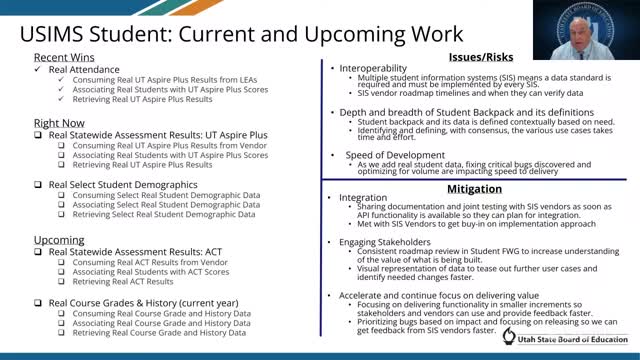USBE staff publish enrollment and dropout dashboards; analysis shows most dropouts reenroll within a year
January 11, 2025 | Financial Operations , Utah Board of Education, Offices, Departments, and Divisions, Organizations, Utah Executive Branch, Utah
This article was created by AI summarizing key points discussed. AI makes mistakes, so for full details and context, please refer to the video of the full meeting. Please report any errors so we can fix them. Report an error »

USBE staff presented a data dashboard that visualizes enrollment trends from 2008 through 2024 across districts, schools, grades and student subgroups (English learners, economically disadvantaged, special education, homeless). The dashboard is available via a link in the committee materials and is designed for interactive filtering by LEA, school and grade.
The nut graf: staff also delivered a focused analysis on student exits and reenrollments: in the cohort reviewed, 2,780 students were recorded as dropouts; of those, 140 later reenrolled in the state data system, with the majority of reenrollments occurring within about 100 days. The analysis shows 46% of reenrolled students returned to the same school and 75% returned to the same LEA.
Director of Data and Statistics Aaron Brough walked the committee through the dashboard and explained how users can compare trends across subgroups (for example, English learners vs. economically disadvantaged students). Brough said the dashboard will be embedded in USBE’s public data gateway and that staff will update it after year‑end data are finalized; the current public view covers 2008–2024 and omits incomplete 2025 year‑end data.
On dropout and reenrollment specifics, Brough told the committee the team tracked a cohort of 2,780 students who exited enrollment and found 140 later reenrolled; most reenrollments took place within the first 100 days after exit, and a small share reenrolled after 300 days or more. He cautioned that the state database only captures students who reappear in Utah’s K‑12 system; students who leave Utah or who never reenroll cannot be located in state records. Brough also said the state does not have data to draw causal links to human trafficking, immigration status or faith traditions; those topics are outside the available administrative data.
Ending: The dashboard and the dropout analysis will be available to board members and the public via USBE’s data gateway, and staff offered to provide follow‑up briefing or additional filters on request.
The nut graf: staff also delivered a focused analysis on student exits and reenrollments: in the cohort reviewed, 2,780 students were recorded as dropouts; of those, 140 later reenrolled in the state data system, with the majority of reenrollments occurring within about 100 days. The analysis shows 46% of reenrolled students returned to the same school and 75% returned to the same LEA.
Director of Data and Statistics Aaron Brough walked the committee through the dashboard and explained how users can compare trends across subgroups (for example, English learners vs. economically disadvantaged students). Brough said the dashboard will be embedded in USBE’s public data gateway and that staff will update it after year‑end data are finalized; the current public view covers 2008–2024 and omits incomplete 2025 year‑end data.
On dropout and reenrollment specifics, Brough told the committee the team tracked a cohort of 2,780 students who exited enrollment and found 140 later reenrolled; most reenrollments took place within the first 100 days after exit, and a small share reenrolled after 300 days or more. He cautioned that the state database only captures students who reappear in Utah’s K‑12 system; students who leave Utah or who never reenroll cannot be located in state records. Brough also said the state does not have data to draw causal links to human trafficking, immigration status or faith traditions; those topics are outside the available administrative data.
Ending: The dashboard and the dropout analysis will be available to board members and the public via USBE’s data gateway, and staff offered to provide follow‑up briefing or additional filters on request.
View full meeting
This article is based on a recent meeting—watch the full video and explore the complete transcript for deeper insights into the discussion.
View full meeting

